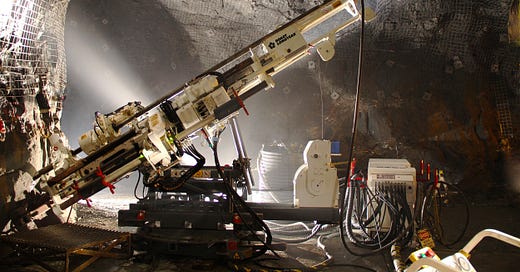Old geos refer to the diamond drill as “the truth machine”.
You can have all the soil samples, outcrop rocks, LIDAR maps, VTEMs and induced polarization studies you want, but, at the end of the day, it is the drill which tells the story.
Junior resource companies in Canada can and do drill all year round. Companies actually wait for the ground to freeze and lakes to ice over so they can move drills to inaccessible locations or drill right through the ice and into a lake bottom. But “drilling season” is generally understood to be from as early as March 15 to as late as Halloween. Again, depends on where you are.
In parts of Canada, drillers might get to work in early March and then pause for Spring breakup when the ground turns to impassable muddy soup. In the North drilling often has to wait for there to be enough daylight for helicopters to fly. In the mountains, you have to wait for twenty feet of snow to melt.
Some years drills and crews are scarce in particular areas. And, of course, companies have to have their treasuries full enough to actually pay those crews. However, eventually, everything is in place and a predictable sequence of events occurs heralded by press releases.
drill is mobilized
drill is turning
holes 1-x are completed
core has been split and sent for assay
results
If only it was that straightforward. Drilling is very much an art as much as it is a science. For the layperson, and I am very much that person, the idea of drilling is that you go straight down for x meters and see what you can find. Which, very occasionally is what happens. But most of the drill holes I have seen are, in fact, drilled at an angle because most deposits are, to some degree, tilted relative to surface.
But the first question is not the angle, the first question is the type of drill. Broadly, there are three types of drill, diamond, reverse circulation and RAB standing for rotary air blast.
A diamond drill carves out a hole the center of which is the “core”. In ideal conditions, that core is brought to surface in perfectly round pieces, each the internal diameter of the cutting head. That’s the theory, in practice, the core is often somewhat or significantly broken.
Diamond drills come in a variety of sizes. The larger the diameter the more information a geologist can glean from the core extracted, however, the larger the diameter the more expensive it is to run the drill. Most junior resource companies have to content themselves with core less than three inches in diameter.
A cheaper alternative to diamond drilling is reverse circulation drilling. Here a drill bit is literally hammered into the rock with a pneumatic reciprocating piston and the shattered fragments of the rock are blown back up the drill pipe using either compressed air or fluid and bagged at surface for subsequent assay. This can be substantially cheaper and faster than diamond drilling and can be used to perform reconnaissance drilling. RC drilling can go quite deep (300 meters+) with a large rig.
RAB drilling is reverse circulation’s lightweight cousin. It always uses compassed air to bring samples to surface. Generally, RAB drilling is significantly less than 100 meters. It offers the advantage of speed and is useful in providing samples at shallow depths which can indicate mineralized material under layers of overburden.
Picking and accessing the right drill for the project is just one element of the drilling question. Where to drill and how to drill are key questions. Good maps, soil samples, sediment samples from catchment areas, placer miners working a creek, old mine workings and, once in a while, an actual mineral bearing outcrop, as well as VTEM and IP results where available, all guide geos when they are picking targets.
In the early stages of exploration drilling, RC and RAB drilling may make more economic sense than diamond drilling. RAB drilling runs $12-20/meter, RC $30-55/meter, diamond drilling starts at $110 per meter and goes up, often way up, from there. Interestingly, it is possible to use RC drilling for a couple of hundred meters and then switch over to diamond drilling when you are through the overburden.
Drilling a property is really a real-time science experiment in which a theory - for example “there is a copper porphyry three hundred meters down which is two hundred meters thick and runs a kilometre in each direction” - is tested against the evidence disclosed by the core. In the process, a lot of other information is revealed: the type of rock found at depth, changes in that type, the inferred orientation of the potential deposits and, the number everyone will be waiting for, the grades recovered.
As with any experiment, things can and do go wrong. A drill can encounter “bad” rock, an unexpected void, rock much harder than expected, the drill itself may veer off course, it may break in an unrecoverable way: in fact it is remarkable that drilling is as successful as it is.
While some holes are labelled “Discovery” holes, see BIG.V’s October 10, 2023 release where it hit what may be a “blind” copper porphyry, the vast majority of drill holes simply add data about a deposit. Data which help determine if mining that deposit makes economic sense.
The drill is indeed a truth machine, but it reveals its truth slowly, one hole at a time, one drilling season at a time.
Can’t wait!
[Disclaimer: I hold a position in BIG.V. I may buy or sell at any time. This is not investment advice. Do your own due diligence, do it hard. Call the CEO.]




Wow, thats a nice introduction to drilling. Great, thanks !